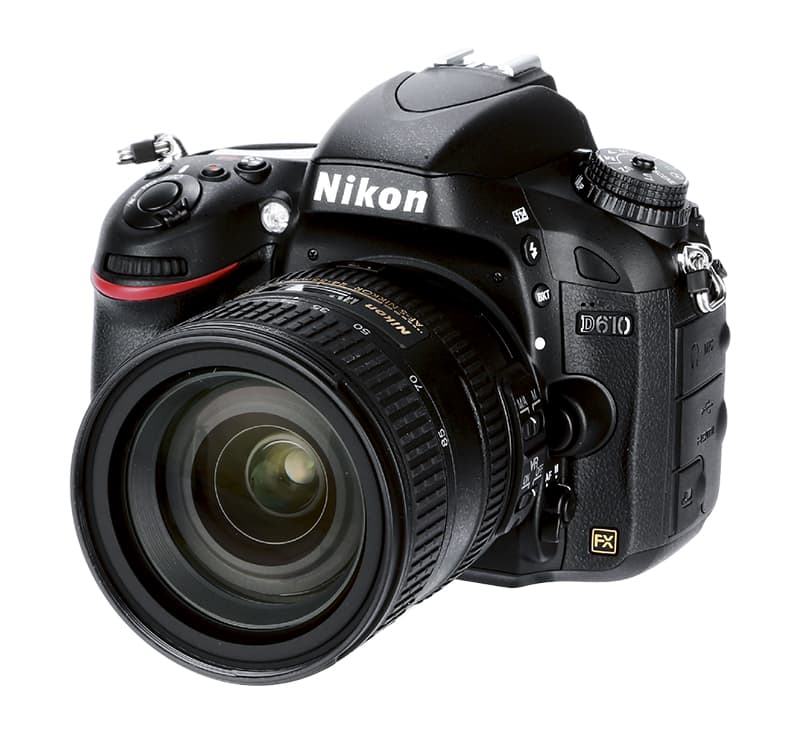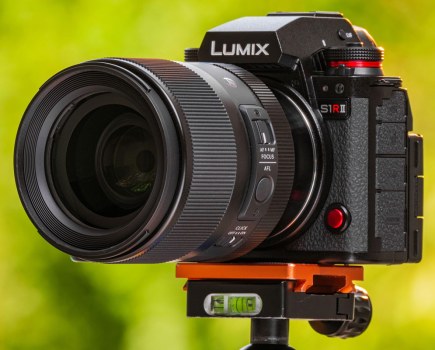Nikon D610 at a glance:
- 24.3-million-pixel, full-frame CMOS sensor
- Optical viewfinder with 0.7x magnification
- ISO 100-6400 (extended to ISO 50-25,600)
- 39-point AF system with nine cross-type points
- 6fps burst shooting
- Street price around £1,560 body only
Nikon D610 review – Introduction
The Nikon D600 scored highly (84%) when we tested it last year (AP 13 October 2012), and I’ve been a big fan of it. However, the problem was that after around 3,000 shots some users started to experience dust/oil spots appearing in the upper-left portion of the frame. Hard to clean, Nikon was forced to issue a ‘service advisory’ and the D600’s reputation never quite recovered.
Just over a year later, we now have the D610. Its arrival suggests that Nikon wants to draw a line under the bad press the D600 has received in some quarters and start afresh. But with limited updates, is there much to get excited about?
Nikon D610 review – Features
The Nikon D610 sees only three obvious improvements over its predecessor: the burst speed has been improved from 5.5fps to 6fps; there’s a new ‘quiet continuous’ mode that shoots at 3fps, with the noise of the shutter release dulled; and the auto white balance has improved colour rendition in artificial lighting and gives more realistic skin tones. The first two features can be attributed to the D610’s new shutter mechanism, which perhaps points to the cause of the issue with the D600, although this can’t be corroborated.
As with the D600, the D610 includes a 24.3-million-pixel, full-frame CMOS sensor that supports a built-in 1.5x DX crop mode. So, if you currently have an APS-C-format Nikon DSLR, you can use your DX-format lenses on the D610, albeit at a reduced resolution of 10.5 million pixels. Combined with the Expeed 3 image-processing engine, the D610 offers a native ISO range of 100-6400 that can be expanded to an ISO equivalent of 50-25,600.
Thanks to the built-in flash, the Nikon D610 offers wireless flash control that allows you to trigger remotely positioned, compatible flashguns for more creative lighting, with the option of TTL or manual control.
As with the D600, wireless transfer of images is supported via the optional WU-1b mobile adapter, but it’s a shame not to see this facility integrated into the D610.

Image: This shot was taken with studio flash using the 1/250sec maximum flash-sync speed
Nikon D610 review – Build and handling
While the internal features are pretty much the same as those in the D600, the D610’s design, layout and build are also very similar. Although not feeling quite as robust as the professional-level D800, the D610 still feels like a professional piece of kit in the hand. This is thanks to the magnesium-alloy construction of the top and rear covers, with the remainder of the shell formed from toughened polycarbonate plastic. Combined with the same high level of weather-sealing as the D800, to protect the camera against dust and moisture, it results in a hardy but lightweight shell.
In the hand, the D610 is nicely proportioned, with a comfortable but not overly large handgrip. It is also logically laid out, so existing Nikon users, and those who have been tempted to jump brands, should feel comfortable shooting with it.
Along the top-plate is a fairly uncluttered mode dial, beneath which is a release-mode dial that now includes quiet continuous shooting mode. Both feature a dedicated locking button to avoid any unintentional dial turning during shooting, although I’d have liked to have seen something a little less fiddly for the release-mode lock.
The D610 is dotted with a variety of external access points for a range of shooting controls, with large and comfortable buttons to press, while the dual front and rear command dials fall comfortably to the hand and are easy to turn. While it does have its little niggles, overall the D610 is a very satisfying camera with which to shoot.
Nikon D610 review – Metering and dynamic range

Image: The Nikon D610’s matrix metering system handled this high-contrast scene well
Metering
Like the Nikon D7100 and D600, the D610 uses a 2016-pixel RGB sensor, and on the whole it performs well, although I did find it necessary on the odd occasion to dial in -0.3EV to -0.7EV to retain highlight detail in relatively contrasty scenarios. For precise exposures, if time permits, I’d recommend switching to the D610’s spot-metering mode, with readings taken from the selected AF point.
Dynamic range
The D610 offers a very broad dynamic range, measured at 14.4EV, which is one of the widest of any camera. If that’s not enough, its Active D-Lighting is available to lighten shadow areas in the scene (JPEG only). There’s an HDR mode too, with shots taken in quick succession at different exposures and then combined in-camera for an even greater tonal range. Again, this is a JPEG-only mode and I would strongly recommend a tripod for this.
Nikon D610 review – Autofocus
The D610 sports a generous 39-point AF system, with the Multi-CAM 4800 unit featuring nine cross-type variants at the centre for improved AF acquirement while the system is also locking onto your subject in conditions as poor as -1EV. Not only that, but because the AF system is hooked up to the D610’s scene-recognition system, 3D focus tracking is possible – which sees the D610 utilise a predictive system to track your subject as it moves round the frame.
Peering through the viewfinder, it is disappointing to see the AF points grouped relatively closely together in the centre of the frame, although that’s the only major issue here. The D610’s AF will, in most situations, lock on quickly without any hunting – even in relatively poorly lit conditions.
Selecting the AF point is done via the D-pad at the rear. In some situations it might be desirable to reduce the active AF points to 11 to enable quicker movement around the frame.
It must be said that the sophisticated AF tracking options at your disposal when AF is set to continuous work impressively well. Of course, you’ll have to spend a little time learning the system – there’s a choice of nine, 21 or 39-point dynamic AF modes on top of the 3D tracking mode, but the set-up that’s most appropriate for you will depend on how erratically your subject is moving.
Nikon D610 review – Noise, resolution and sensitivity

These images show 72ppi (100% on a computer screen) sections of images of a resolution chart, captured using the Sigma 105mm f/2.8 Macro lens. We show the section of the resolution chart where the camera starts to fail to reproduce the lines separately. The higher the number visible in these images, the better the camera’s detail resolution at the specified sensitivity setting.
The D610 uses the same 24.3-million-pixel sensor as that found in the D600, and the quality of results was as expected. The level of detail achievable with raw files is very impressive, scoring 32 at its base ISO of 100, with JPEGs only just behind at 30 – thus edging out its closest rival, the 20.2-million-pixel Canon EOS 6D, which scores 30 for raw.
Raw files and JPEGs at lower sensitivities display smooth and detailed results with no noise. It’s only at ISO 3200 that subtle luminance and colour noise begin to creep in, becoming a little more pronounced at ISO 6400, although images are certainly usable.
While in-camera processing can be an issue at higher sensitivities for some cameras – it often results in a waxy look – the D610’s JPEG files hold up very well. This is thanks to fairly light processing being applied so that not too much detail is sacrificed, although for best results we’d recommend shooting raw and spending a little time post-processing the image to achieve the better result.
Nikon D610 review – White balance and colour

Image: The level of fine detail rendered by the D610’s sensor is excellent
As with the D600, the camera’s auto white balance performs very well – it was good at judging most scenarios, ably neutralising any colour casts in the scene. As we’ve seen with other recent Nikon DSLRs, there’s also an Auto 2 mode designed to maintain a warm lighting colour under artificial light, should you want to retain the mood of the scene rather than produce a more neutral result.
Colour rendition in the D610’s standard colour mode is natural, but for those looking for more punch there’s the vivid setting, while mono shooters will welcome the range of black & white filter effects on offer.
Nikon D610 review – Viewfinder, live view, LCD and video
If you’re used to an APS-C-format DSLR viewfinder, you’ll be pleasantly surprised by the quality of the one found in the D610. Its 100% coverage and 0.7x magnification deliver a large and bright display. There’s a handy on-demand grid overlay that can be activated too, aiding composition and helping to battle slightly wonky horizons.
The D610’s 3.2in screen looks impressive, and while it doesn’t use OLED technology, detail is still well rendered and a decent amount of contrast is displayed. The viewing angle is also good, and while some may have liked to see touchscreen functionality, there’s a host of quick access buttons at your disposal so it’s not an issue in use.
The AF performance is pretty sluggish in live view. It is useful for slower close-up work, but if you intend to track your subject it’s not a realistic expectation. This is not a problem unique to the D610 – most DSLRs struggle in similar circumstances – but it’s worth considering if you intend to shoot in this way.
The D610 features reasonable video functionality, recording full HD footage at 1920×1080 pixels at a choice of 30fps, 25fps and 24fps, or at 1280×702 pixels at 60fps, 50fps, 30fps or 25fps, both in the MOV file type. There’s a microphone input and the headphone jack allows proper monitoring of sound. It is disappointing to see that the D610 doesn’t offer full control over ISO and shutter speed, although aperture can be preset before you start shooting.
Nikon D610 review – Our verdict
The question people will want answered is whether the D610 suffers from the same dust or oil trait that befell the D600. The good news is that it doesn’t – I took more than 3,000 shots against an illuminated white background in the AP studio and, reviewing images before and after at 100%, I’m happy to report there was no sign of any oil or dust on the sensor.
So where does that leave the D610? It wouldn’t be unreasonable to be cynical about its arrival so quickly after the D600, with its very minor updates hinting at what might be seen by some as simply a marketing fix for the tarnished D600. There could be some truth in this, but the D610 is still a fantastic piece of kit.
Despite the absence of Wi-Fi connectivity, the specification is incredibly comprehensive. There are no major gaps to deter those who are thinking of upgrading. The build quality and finish are very good, with the blend of magnesium alloy and tough plastic delivering a sturdy but relatively lightweight feel. In use, it delivers the goods, with a sound AF system and logically laid-out controls, while the full-frame chip will deliver highly detailed and rich images. All in all, the D610 is a very well-made, well-thought-out and high-performing DSLR, regardless of its heritage.







